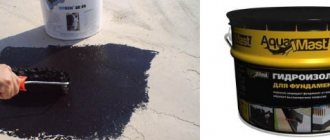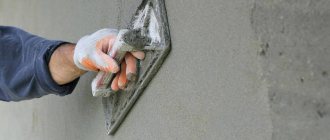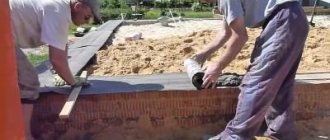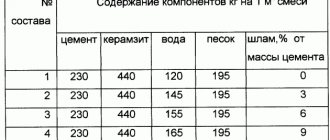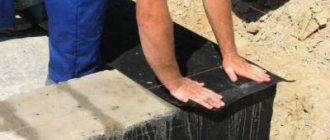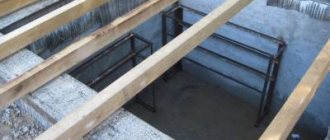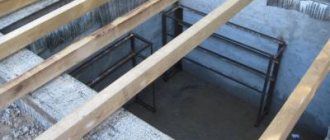A concrete foundation that is not protected by a waterproofing layer becomes vulnerable to moisture.
Groundwater and storm water gradually destroy the material, which reduces the strength and load-bearing capacity of the foundation.
To prevent these processes, bitumen-based waterproofing is often used during foundation construction.
We will talk about the properties and use of bitumen mastic for foundation waterproofing in the article.
Composition, properties and application of the material
Liquid mastic for foundation waterproofing contains bitumen and special additives that give the composition the necessary consistency and improve the performance properties of the material. Depending on the type of waterproofing material, water or aggressive chemical compounds can be used as solvents: nefras, kerosene, etc.
In addition to the main component (bitumen dust) and solvent, the composition may include various additives . Rubber makes the waterproofing layer more elastic, so the waterproofing does not deteriorate when the foundation shrinks or soil layers shift.
The cement used in some types of mastic significantly increases its strength after hardening. Special polymers used as plasticizers perform the same function and further improve the plasticity of the material.
Waterproofing mastic for foundations, made on the basis of bitumen, is widely used in the construction of residential and non-residential buildings. The material is optimally suited for use in regions with variable climates, as it can withstand sudden temperature changes and severe frosts.
The popularity of bitumen mastic is also due to the following factors:
The waterproofing coating is easy to apply to the surfaces being treated and has high adhesion to concrete.- The bitumen layer is quite elastic, thereby reducing the risk of cracks in the protective coating.
- Such materials are biologically inert and do not contribute to the proliferation of fungi and harmful microorganisms.
- Bitumen-based waterproofing easily withstands exposure to ultraviolet radiation.
Bitumen mastic should not be confused with a primer, which has a similar composition. The first is used for finishing waterproofing, while the second is used for preliminary preparation of surfaces.
The main difference between mastic and rolled waterproofing coatings is its higher tightness. When applied correctly, the protective layer is seamless and does not allow moisture to pass through .
Rolled products, in turn, provide less tightness and require additional effort in the process of gluing them. Sheets of such waterproofing are laid in different ways: fixed on a self-adhesive layer, fused to concrete, etc.
Also, rolled and liquid materials differ in price. If 1 kg of mid-price class bitumen mastic costs 60-100 rubles and is designed for 1 square meter (for single-layer application), then 1 square meter of cheap roll waterproofing will cost 15-25 rubles. Premium roll materials (for example, Technonikol) are comparable in cost to bitumen mastic and are sold at a price of 150-180 rubles/m2.
What is the difference from hot bitumen?
There are two types of bitumen mastic
- cold,
- hot application.
The cold method applies liquid compositions that do not require preheating before application to the surface to be treated.
Such materials can be sold either ready-made (can be used without prior dilution) or partially ready-made (must be mixed with a solvent).
Hot bitumen, in turn, needs to be heated in a bitumen cooking machine or using other available means - for example, in a metal container on a fire. In its “raw” form, the material has a solid or powdery consistency.
During the cooking process, additional impurities may be added to the bitumen , depending on the conditions of further operation of the waterproofing layer and the specific requirements for its characteristics.
Universal base – bitumen
The most common material for these purposes is bitumen for waterproofing. It is a resin-like product whose main characteristic is its insolubility in water. In construction, its liquid form is used, which can be used both in a heated and cooled state.
There are three types of liquid bitumen: those that thicken quickly (BG), at an average speed (SG) and slowly (MG). In each of these groups there are several leading brands, the main difference between which is viscosity and softening point. For waterproofing, petroleum products intended for construction and roofing work are used. Each brand of bitumen has its own characteristics. As an example, here are some of them that are most suitable for water protection work:
- BN 70/30: characterized by a fairly high softening temperature of 70-80 degrees C, breaks without fragments.
- BN 90/10: softening temperature – 90-110 degrees C, excellent adhesion, shatters into large shiny pieces from strong blows with a hammer.
Many novice builders ask themselves a question: how to prepare bitumen? To do this, you need a metal container into which the molten substance is poured, combining with some liquid solvent. The resulting mass must be thoroughly stirred until the required consistency is obtained. Voila - the coating material is ready!
Main varieties
Depending on the type of solvent used, there are two main types of bitumen mastic:
With chemical solvents . Such materials are diluted with quickly evaporating solvents: gasoline, white spirit, etc.- Water-based. In such compositions, the solvent is ordinary water.
Due to the absence of toxic chemical additives, these materials are more environmentally friendly and safe. Water-based waterproofing does not cause serious harm to the environment or human health.
Also, mastics are classified according to the chemical composition of the base:
- mineral - products may contain cement, ash, chalk and other powder additives;
- bitumen-emulsion - such materials are aqueous solutions of bitumen dust;
- bitumen-polymer - the composition includes rubber crumbs and polymer binder additives.
Cons depending on the type
If we talk about types of bitumen, then the mastic can be either cold or hot.
Cold has several disadvantages:
- For waterproofing there should only be moderate climatic conditions. Usually water-based mastic is used.
- For the northern part of the country, mastic containing polymers is suitable. It can be used at sub-zero temperatures.
- One-component mastic has a long working time, while two-component mastic is much more difficult to use. It freezes almost immediately.
The hot variety of mastic has difficulties when working. It needs to be heated initially to 300 degrees. For this process it is necessary to involve specialists as well as equipment. Here you need to follow the necessary safety precautions and not ignore them. If you have no work experience, then you need to seek the help of professionals.
Popular brands
The modern building materials market offers a large selection of waterproofing bitumen coatings for treating foundations. Products manufactured under the following brands are especially popular:
- Aquamast. Aquamast brand materials are distinguished by their affordable price and balanced characteristics, and are supplied in 18 kg buckets.
- Aquaizol. Bitumen mastic for foundations, which is produced under this brand, is sold mainly in 10-kilogram containers. The main advantages are good adhesion and long service life.
- TechnoNIKOL. One of the most popular manufacturers of bitumen mastic in Russia and the CIS countries. Offers high-quality bitumen mastic at reasonable prices.
- Bitumast . Waterproofing materials of this brand have a wide range of applications, suitable for treating foundations, roofing structures, floors, etc.
Features of foundation waterproofing
The foundation, even if it stands under a small building, takes on a colossal load, to which is added soil pressure. In most cases, a strip or monolithic type is chosen for permanent buildings, but one way or another it is necessary to do thorough waterproofing. It protects from destruction not only the concrete outside the foundation, but also the reinforcement inside, which is responsible for the rigidity of the entire structure. If it starts to rust, the base will not last very long.
If the waterproofing is of poor quality (we are not talking about its absence), underground or sedimentary water will quickly penetrate through the porous structure of the concrete and damage the metal frame. As a result, the foundation will not be able to withstand the load from the walls, ceilings and roof, and the house will literally begin to burst at the seams.
Regardless of the chosen method of waterproofing, it is necessary to perform some preparatory work:
- Find out at what depth the groundwater lies on the construction site (the type of waterproofing, the choice of materials and the thickness of application depend on this).
- Take into account the possibility of flooding of the site, especially if it is located in a lowland or on loose soil.
- Determine the degree of heaving of the soil (on heaving soils, the foundation requires additional strengthening, otherwise in the spring the earth will simply push the house out, or it will warp).
- Operating conditions of the future building (if you are building a warehouse, then waterproofing should be maximum).
- Financial possibilities (fortunately, the price of waterproofing the foundation with bitumen mastic is not too high, regardless of the volume of work).
Methods of foundation waterproofing
There are only two types of foundation waterproofing: vertical and horizontal. In the first case, the foundation walls are processed using rolled materials. This work is relevant both during the construction of a house and after its commissioning.
Horizontal waterproofing is carried out during the construction of a house, and this work takes about 10-17 days. The process involves not only treating the base with waterproofing material, but also laying a so-called drainage cushion made of sand, crushed stone and gravel. Drainage is mandatory in all cases, especially if groundwater lies close to the surface.
The foundation waterproofing option shown in the figure above is best suited for protecting strip and monolithic foundations. In the case of a monolithic type, experts recommend using combined insulation, combining vertical and horizontal methods. However, if only horizontal is chosen, then it is best to use rolled bitumen materials or liquid rubber, since they reliably protect the joints and crevices between the elements.
Criterias of choice
When purchasing bitumen mastic, you need to pay attention to many different factors.
Purchasing low-quality waterproofing may result in the protective coating deteriorating prematurely and no longer protecting the foundation from moisture.
Having saved a thousand rubles on high-quality material, you can end up with a much larger sum in a few years , when the need arises for major repairs or restoration of a destroyed foundation.
When choosing a waterproofing coating, you should consider the following parameters:
Composition of the material .
Water-based, bitumen-polymer, mineral and other types of bitumen mastics are designed for different operating conditions. It is necessary to take into account the peculiarities of the local climate and, based on this criterion, select a composition with an optimal temperature regime, which is indicated on the material label.- Average consumption . As a rule, liquid mastics based on chemical and aqueous solvents are applied to surfaces in two layers at a rate of 1-1.5 kg per square meter (for one layer). The consumption of hot applied waterproofing is almost 2 times higher.
- Drying time of the layer . This parameter depends on the chemical composition of the material and must be indicated on the product packaging. Depending on the type of mastic, drying time can vary from 5-7 hours to 1 day.
The material should only be purchased from a trusted place: in a large store, directly from the manufacturer or from its official distributors. By purchasing mastic on a regular market or in a little-known online store, you can get defective or diluted homemade material.
How to distinguish low-quality?
To avoid encountering a fake, you need to pay special attention to the weight of the material . By this parameter you can distinguish a low-quality product without even opening the bucket of mastic.
The fact is that liquid bitumen waterproofing has a lower density than water. On average, 1 kilogram of mastic takes up a volume of about 1.1-1.15 liters. Therefore, for example, 20 liter buckets can be used for 18 kg packages.
When purchasing, you should ask the seller to weigh the material . If the weight turns out to be greater than indicated on the package, this may indicate that the liquid mastic has been diluted with water. At the same time, it is also worth considering the weight of the bucket and not confusing the net and gross weight.
What do we pay attention to?
Protecting the foundation of your home with your own hands is a difficult task, but possible. There are many factors to consider, including:
Waterproofing of buried foundation
- the type of soil on the site (sandy, clayey, rocky, etc.) and its heterogeneity;
- the strength of its heaving;
- groundwater level;
- underground fluid pressure;
- seismic activity of the area;
- features of the building (type of foundation; material used in construction; number of storeys of the building, etc.)
Application technology
Before starting waterproofing treatment of the foundation, it is necessary to perform a number of preparatory procedures. First of all, you need to thoroughly clean the treated surfaces from all kinds of contaminants: dust, soil, etc.
You should also get rid of small irregularities and carefully level the horizontal and vertical surfaces of the foundation. Before applying mastic, it is recommended to treat the concrete structure with a layer of primer.
The method of applying mastic depends on the selected material. Liquid bitumen waterproofing is applied using the cold method. The foundation is evenly coated with a layer of mastic using:
- paint brushes,
- spatulas,
- rollers and similar tools.
The coating can also be applied mechanically, using special sprayers operating under pressure. After the first layer has completely dried, the second one is applied.
When applying hot, you need to melt solid bitumen . When heated to a certain temperature, it becomes viscous and fluid - it is in this state that it is applied to the surface of the foundation. In this case, it is necessary to strictly observe precautions so as not to get a thermal burn when coming into contact with hot mastic.
Don't forget about the basement!
Consider another situation in which moisture protection is a top priority. It is associated with the presence of a basement in the house. It also needs to be coated with special agents that prevent the penetration of liquids. Moreover, surface treatment in this case should be carried out both outside and inside; cases of leakage and bursting of heating and water pipes in private homes are, alas, not uncommon. And here mastic mixtures come to the rescue again.
Many people ask the question: how to waterproof a basement? In fact, the technology for preparing and applying the bitumen mass remains the same as when processing the foundation. The only difference is the need for double-sided surface treatment, which was mentioned above.
Price
The cost of waterproofing material depends on many different factors.
The main pricing criterion is the composition of the bitumen mastic, the type of base and solvent used. Coating waterproofing, which is mixed with synthetic solvents, has a more affordable cost compared to water-based ones.
Hot-applied bitumen waterproofing is less expensive than cold-applied materials. Products of these types may differ in cost by 3-5 times .
If solid bitumen, which is applied hot, costs an average of 25-30 rubles per kilogram, then high-quality premium water-based mastic can cost up to 150-200 rubles / kg.
For comparison, we suggest considering a table with prices for liquid coating mastic of several brands popular in the domestic building materials market:
| Brand | Average price per 1 kg | Packing |
| TechnoNIKOL | 80 rub | 18 kg |
| Aquaizol | 120 rub. | 10 kg |
| Aquamast | 70 rub | 18 kg |
| Bitumast | 100 rub | 18 kg |
Everything you need to know about foundation waterproofing can be found in this section.
When water is not a friend, but an enemy
First you need to understand how moisture can seep through concrete, which only at first glance seems to be a monolithic material. In fact, it is penetrated by numerous “pores” and “capillaries”, through which the liquid slowly but surely continues its movement into the very depths of the structure. On its way, it “meets” cement, as well as various salts. The result of this interaction is the emergence of chemical compounds leading to the fragility of this seemingly super-strong building material. And in winter, the moisture trapped in the cracks freezes and simply tears apart the concrete “inside.”
Protection against water from outside
The situation is aggravated by the fact that the source of excess moisture can be:
- groundwater;
- rains;
- melting snow;
- overflowing rivers, etc.
So, what does the destructive power of water lead to?
- there is high humidity in the premises;
- mold and various fungi appear on the walls inside;
- plaster, paint and wallpaper are peeling off;
- cracks form on the walls;
- there is a general “subsidence” of the house.
As you know, it is easier to prevent a problem than to eliminate its consequences. And coating waterproofing is exactly what the owner of the future home should do.
